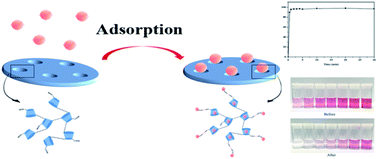Preparation of a carboxymethyl β-cyclodextrin polymer and its rapid adsorption performance for basic fuchsin†
Abstract
The presence of dyes in a water system has potential adverse effects on the ecological environment. The conventional cyclodextrin (CD) polymer only has CD cavities as adsorption sites and exhibits slow adsorption for dye removal. In this study, we designed a novel carboxymethyl β-CD polymer (β-CDP-COOH). The structural properties of β-CDP-COOH were characterized as an irregular cross-linked polymer with negative surface charge, and the introduction of carboxymethyl groups greatly enhanced the adsorption ability of the β-CD polymer to basic fuchsin (BF). The maximum removal efficiency of β-CDP-COOH (96%) could be achieved within 1 min, whereas that of conventional β-CD polymer (70%) was achieved after 50 min. The adsorption mechanism revealed that the adsorption behavior of β-CDP-COOH could be effectively fitted with the pseudo-second-order kinetic model and Langmuir isotherm. Both CD cavities and carboxymethyl groups were effective adsorption sites, so β-CDP-COOH had an advantage in adsorption capacity over the conventional β-CD polymer. This study indicated that β-CDP-COOH is a potential highly efficient adsorbent for the removal of cationic dye contaminants.



 Please wait while we load your content...
Please wait while we load your content...